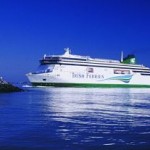 “Are you scared of flying?” is the usual taxi driver’s question en route to Dublin Port. “No, I just like travelling this way” is what I say now, as getting into a carbon debate at 7am is not good for anyone’s head.
“Are you scared of flying?” is the usual taxi driver’s question en route to Dublin Port. “No, I just like travelling this way” is what I say now, as getting into a carbon debate at 7am is not good for anyone’s head.
In fairness, getting into a carbon debate isn’t good for anyone’s head, especially if you are trying to research a ferry’s footprint. Up until a year ago, most ferry companies came up blank if you asked for carbon emission data or whether their sick bags are biodegradeable. However, the Passenger Shipping Authority, the UK trade association ferries and cruises, recently commissioned a CO2 study; the results showed an average of 0.12kg CO2 per passenger/km. So, on a 100 kms crossing from Dublin to Holyhead, my footprint is 12kg of CO2. Putting that in perspective, driving 100 kms in an average car emits, 28kg CO2. ‘Average’ is a big word in CO2 talk. The PSA goes on to tell us that ‘some’ companies recycle, ’some’ are restricting non-polluting paint, and ‘some’ are improving fuel use.
However, the stats are vague, with little information on which company is greenest. One thing is for sure, the newer the ship, the better. Irish Ferries claims to operate “one of the youngest and most fuel efficient ferry fleets”. Its carbon research produces average figures too, 1.13kg/km for each car, with an average car load of 3.4 people. More averages, more confusion. What is not top of their green list is their linking with Tesco Card for bargain prices, which is always frustrating for some of us who are trying to shop locally.
Stena Line’s eco-policy aims to reduce energy consumption by 5% a year, by changing propellers, adjusting timetables and speed analysis. They use non-lead paints and recycle engine heat for onboard heating, and recycle their waste. I asked one member of staff recently if my plastic cup was going to be recycled, as it was piled into a black binbag, with a load of chips and ketchup. The silent ‘am I bovvered?’ response put me quickly back in my little green box. Hopefully they are all disposing of waste properly, but if they are, I wish they would tell us all about it.
At the end of the day, the carbon calculators still tell me that if I fly Dublin to London, for example, my emissions are double that of going by ferry and train. Which leads to another problem; ferry travel is still aimed at car-drivers, rather than train passengers. Once you start pumping the gas on the autoroutes at the other end, you may as well have flown. Ferry ports in France are well connected to trains, but less so closer to home. Dun Laoghaire and Holyhead have train stations, but Dublin Port is tricky if you miss the bus. Arriving into Belfast port at dawn is just downright spooky, it is so deserted, and miles from anywhere.
To link up with trains, check out the gloriously geeky website, www.seat61.com, which tells you how to get anywhere in the world by train and ferry. There are great ferry and rail bargains to the UK with www.sailrail.co.uk, and Stena Line also offers rail-sail deals at www.stenaline.co.uk/ferry/rail-and-sail.
As for the hassle factor, ferries and trains win hands down for me, travelling solo or as a family. You can carry all the makeup you want onboard a ferry, as well as bikes, buggies, and bottles of water. My bag was searched at a ferry port recently, which I found a little amusing as a hundred or so cars drove on beside me, packed to the gills with everything possible, and not being searched. But don’t get into that debate with security men at 7am either. On average, they don’t thank you for that.
(First published in The Irish Times, 07 March 09)
